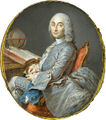Template:Selected anniversaries/June 17: Difference between revisions
No edit summary |
No edit summary |
||
| Line 3: | Line 3: | ||
File:César François Cassini de Thury.jpg|link=César-François Cassini de Thury (nonfiction)|1714: Astronomer and cartographer [[César-François Cassini de Thury (nonfiction)|César-François Cassini de Thury]] born. In 1744, he will begin the construction of a great topographical map of France, one of the landmarks in the history of cartography. Completed by his son Jean-Dominique, Cassini IV and published by the Académie des Sciences from 1744 to 1793, its 180 plates will be known as the Cassini map. | File:César François Cassini de Thury.jpg|link=César-François Cassini de Thury (nonfiction)|1714: Astronomer and cartographer [[César-François Cassini de Thury (nonfiction)|César-François Cassini de Thury]] born. In 1744, he will begin the construction of a great topographical map of France, one of the landmarks in the history of cartography. Completed by his son Jean-Dominique, Cassini IV and published by the Académie des Sciences from 1744 to 1793, its 180 plates will be known as the Cassini map. | ||
||John Henry "Professor" Pepper (b. 17 June 1821) was a British scientist and inventor who toured the English-speaking world with his scientific demonstrations. He entertained the public, royalty, and fellow scientists with a wide range of technological innovations. He is primarily remembered for developing the projection technique known as Pepper's ghost, building a large-scale version of the concept by Henry Dircks. Pic. | |||
||1832 – William Crookes, English chemist and physicist (d. 1919) | ||1832 – William Crookes, English chemist and physicist (d. 1919) | ||
Revision as of 06:34, 8 March 2018
1714: Astronomer and cartographer César-François Cassini de Thury born. In 1744, he will begin the construction of a great topographical map of France, one of the landmarks in the history of cartography. Completed by his son Jean-Dominique, Cassini IV and published by the Académie des Sciences from 1744 to 1793, its 180 plates will be known as the Cassini map.
1859: Inventor and crime-fighter Charles Grafton Page uses Gnomon algorithm to forecast and prevent crimes against mathematical constants.
1925: Pharmacologist and chemist Alexander Shulgin born. He will discover, synthesize, and personally bioassay over 230 psychoactive compounds for their psychedelic and entactogenic potential.
1932: Bonus Army: Around a thousand World War I veterans amass at the United States Capitol as the U.S. Senate considers a bill that would give them certain benefits.
1939: Electrical engineer Nikola Tesla uses ultra-low-frequency electrical current to detect and prevent crimes against mathematical constants. His work will later be useful in detecting and removing the Watergate scandal virus.
1972: Watergate scandal (nonfiction): Five White House operatives are arrested for burgling the offices of the Democratic National Committee, in an attempt by some members of the Republican party to illegally wiretap the opposition.





